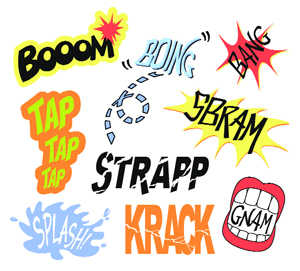Onomatopoeia: playing with sounds
Pitter….. patter….. pitter….. patter…. pitter…. patter.
Pitter-patter, pitter-patter, pitter-patter, pitter-patter.
What do the two lines denote and what is the difference between the two lines? Very easy to decipher. Because the words are self-explanatory: pitter-patter is the sound of raindrops. The first line describes a drizzle and the second a torrent of rain.
We go a little further, and the sentence continues to be effortless to comprehend:
Pitter-patter, pitter-patter, pitter-patter, pitter-patter….. whoosh..... Whoosh.....pitter patter.
That's a gust of wind accompanying the rain.
Forming words by letters that resemble the sound of the things denoted by them is called onomatopoeia. The word originates from Greek onoma (name) and poiein (to make). So, an onomatopoetic word is one that is made from the phonetic resemblance or suggestion of the source of the sound that it describes. Onomatopoeia refers to the property of such words.
It is best explained by examples. Most of us can identify the phonetics in cuckoo, miaow, hiss, buzz, honk, or boom, splash. Or, hiccup, zoom, bang, beep, moo, croak.
Such imitative and naturally suggestive words add drama and poetry to a verse. They are also used for rhetorical effect. A story becomes more lively and interesting by the use of onomatopoeia.
This literary device comes in handy while communicating with children. Children are particularly drawn by the sonorous quality of such words. My little niece responds to chhuk-chhuk train with squeals of delight. She never calls a train without prefixing it with its sound. No wonder that they are so imaginatively and freely used in rhymes and by characters in the kiddies' comic books. Along with the graphic pictures, the action sounds 'boom' and 'thud' and 'miaow' and 'splash' send their imagination soaring to a world of their own. Archie comics from my childhood are etched in my memory. And the Tintin series with the ace investigator Tintin and his dog Snoopy getting into hilarious run-ins with the bumbling identical twin cops abundantly spouting whoops, bangs, slops, splashes remain my favourite.
In fact, if nursery teachers had given us a lesson in onomatopoeia while teaching the rhymes, this word would be commonly known to us today. Remember 'Baa baa black sheep'? Or, the poem that doubles as a chapter of onomatopoeic words of animal noises: 'Old MacDonald had a farm....' It's the best way to learn that a pig goes 'oink-oink', a cat 'miaows', a cow moos, a horse neighs and a duck quacks, and a chick goes 'chick-chick'. Incidentally, besides chicks, many other birds get their names from their calls or sounds they make. Cuckoo is one. In Tamil and Malayalam, the word for crow is kaakaa. The word twitter has acquired an altogether new life in this age of Internet. It is much more than just the sound birds make.
Sometimes things too are named from their auditory characteristics. For example, the fastener is named for the onomatopoeic of the sound it makes: the zip or zipper. Machines and their sounds are also often described with onomatopoeia, as in honk or beep-beep for the horn of an automobile, and vroom or brum for the engine.
Interestingly, onomatopoeias are not the same across all languages. Although a particular sound is heard similarly by people of different cultures, it is often expressed through the use of different words in different idioms. For example, the 'snip' of a pair of scissors is katr-katr in Hindi. Similarly, the 'honk' of a car's horn is tut-tut in French and, bbang-bbang in Korean. And, while the sound of a clock is tick tock in English, it is d? d? in Mandarin, and 'tik-tik' in Hindi. While a train goes chhuk-chhuk in Hindi, it chugs in English.
Onomatopoeic words come in combinations as they reflect different sounds of a single object. For example, a group of words reflecting different sounds of water are; plop, splash, gush, sprinkle, drizzle, drip etc. Similarly, words like growl, giggle, grunt, murmur, blurt, chatter etc. denote different kinds of human voice sounds. The group of words related to different sounds of wind is swish, swoosh, whiff, whoosh, whizz, whisper etc.
Poets use onomatopoeia to access the reader's auditory sense and create rich soundscapes. As Lee Emmett has illustrated:
Water plops into pond,
splish-splash downhill.
warbling magpies in tree
trilling, melodic thrill
whoosh, passing breeze
flags flutter and flap,
frog croaks, bird whistles
babbling bubbles from tap.
hkhetal@gmail.com









